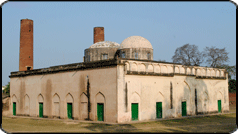Karbala Naseer-ud-Din Haider
Ignominious accounts regarding the life and reign of the second King of Awadh, Naseer-ud-Din Haider, have done irreparable damage to his reputation. More often than not, these were circulated with ulterior motives. One such account 'The Private Life of an Eastern King' by Wiiliam Knighton, first published in London in 1855, proved to be the most damaging because the King was presented as a lewd and characterless and a good-for-nothing character. It made him a subject of light-hearted gossip and banter and butt of jokes for British society. Even his adoption of European manners, dress and etiquette was presented in a comical manner, ignoring the very fact that whatever the King did was in accordance with the advice of his European friends (he had at least five as his advisers). Such accounts slighted the image of the rulers of Awadh in general and Naseer-ud-Din Haider in particular. The idea of the annexation of Awadh was already under the consideration of the British East India Company during the reign of Naseer-ud-Din Haider and the later publication of his private and puolic life as such only served to discredit him further. Actually the idea behind the entire exercise was to pave the way for the annexation of Awadh.
Ironically, Naseer-ud-Din Haider was also partly responsible for strengthening the opinion against him by his erratic behaviour and dual personality that clashed with the moves of his time. Progressive by nature, he encouraged the learning of English and science, provided grants to European schools, even to the prestigious La Martiniere College for Boys, according to a prominent history scholar.
To Naseer-ud-Din Haider goes the credit for building the Taare wali Kothi as an Observatory, for which telescopes and scientific instruments were imported from Greenwich. He also initiated the actual construction of an Iron bridge on the river Gomti at a time when it was a rarity in other parts of the world. Iron parts for the same were shipped from England during his father Ghazi-ud-Din Haider's reign and stacked at Raj ghat, the proposed site for construction of the bridge at Lucknow. On completion of the Chhatar Manzil palace, he installed a steam engine to pump water from the river to flow into the canals of the beautiful gardens opposite the palace aptly called Bagh-e-lram, the garden of paradise.
Along with a hospital that provided treatment according to the traditional Unani system of medicine, he provided another hospital called Dar-ul-Shafa for treatment by European doctors under the allopathic system.
As a step towards social reforms, the King, despite the fact that the majority of his subjects would not like it, decreed the banning of Sati, the practice of burning a wife on her husband's death, at about the same time that Lord Bentinck enforced a similar ban in Bengal.
The British were never in favour of any progress or development achieved through the Nawabs or Kings of Awadh. The incomplete canal scheme of Ghazi-ud-Din Haider, the first King of Awadh serves here as an example. This scheme that meant to connect the river Gomti at Lucknow to the river Ganga at Kanpur was restarted by Naseer-ud-Din Haider but it was interrupted by the British at an advanced stage, when work on just a short stretch near Kanpur remained to be completed. The British obstructed the further digging on the lands that were under their control. Later they highlighted the scheme as technically faulty and the expenditure on it termed as 'wasteful' and cited for 'mismangement' by the Nawabs.
Impulsive, and often fanatical, specially under the influence of his step-mother Badshah Begum, Naseer-ud-Din Haider made some theologically incorrect and absurd innovations. Already unpopular among the Sunni Muslims and Hindus , these moves put him in a collision course with Shia mujtahids (high priests) as well. The resentment was used as an advantage by the British for spreading malicious canards against him.
As with other rulers, Naseer-ud-Din Haider too indulged in womanising. He even thought of obtaining a religious sanction to partake wine on medical grounds. He desired to marry any female he found attractive, irrespective of her caste, creed or religion. It was this weakness for women that was his undoing as one of the trusted woman, Dhania Mehri [Darogha, superintendent of female attendants in the royal seraglio] was won over by the British Resident, Col. Low who induced her to administer poison to the King. At the tender age of thirty-five, Naseer-ud-Din Haider died of poisoning in the night of July 7-8, 1837.
He was laid to rest besides the grave of his beloved wife Qudsia Mahal at Karbala at Iradat Nagar on the other side of the river [ which was being built at her behest ]. She had committed suicide by consuming a lethal dose of arsenic three years earlier after failing to convince the King of her fidelity.
Situated close to the Dali gunj Railway station and adjacent to the Shia Degree College [on Sitapur road], the Karbala being built by Naseer-ud-Din Haider is yet incomplete, even today. It has his marble covered grave [with a taareekh, chronogram inscribed on it], as well as that of Qudsia Mahal in the hall [which is well decorated], but its exteriors are unadorned and plain with two chimney like minarets incorporated in the structure. Perhaps his guilt regarding the innocence of his wife Qudsia Begum, dwindled the King's interest in the completion of the building and ironically, condemning himself to a similar resting place in obscurity, three years later.
Source:
Hindustan Times, City Scan, A Time in History
Wednesday 18.2.1998 — Manipulated fail from grace

